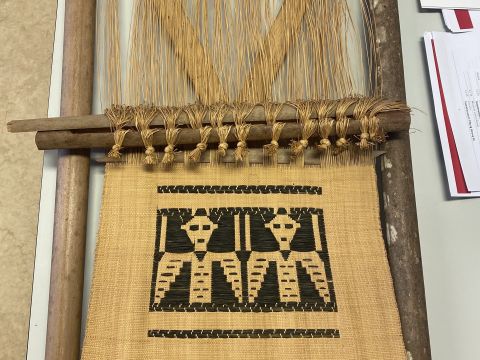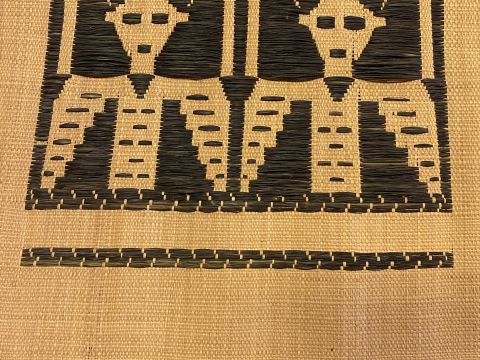Cameroonian Bag Loom
Pictured here is an example of a Cameroonian “bag loom” set with an in-process piece of raffia cloth. It is likely from a town in the Bamenda grass fields in Cameroon’s northwest region. These particular raffia frame looms are used in Western Cameroon and southeastern Nigeria. Although distinct characteristics distinguish looms made in this weaving area, they are part of a continuum of African upright single heddle looms used from the windward coast to the Congo basin. The small, unfinished cloth woven on this loom is of balanced plain weave and incorporates black dyed raffia weft inserts on a naturally colored ground. The primary purpose of these looms was to weave raffia bags (hence the name) which serve an incredible variety of purposes in western Cameroon. In addition, to their utilitarian functions and value as sale items for tourists, raffia bags also serve as important ritual and status items.
Amongst their many uses, Raffia bags can be part of the ceremonial dress of masked spirits, denote membership to secret societies, or be associated with the trappings of royal authority. The example is one of many patterns and techniques used to create bags in this weaving area. Warp stripes, plaids, rya weaving (and other forms of tufting), ikat, basket weaves, embroidery, cut pile, and unique forms of warp manipulation that create pockets directly into the weave are used in various combinations, each imbued with countless shades of meaning. The cultural space in which these objects were made is incredibly complex and is the result of long histories of interaction and patronage between communities all over Cameroon and Nigeria.
This particular loom design is incredibly ancient. However, this is not an object frozen in time. It is the product of a complex network of cultures sharing varying collective histories despite numerous distinct cultural identities. Each of them practices art forms and cultural traditions that simultaneously embody continuity and change. The peoples of Cameroon’s western highlands have had extended interactions with other raffia-weaving semi-Bantu-speaking peoples across the Nigerian border. Their textile histories are also deeply intertwined with the diverse Chadic, Nilo-Saharan, Adamawa, and Fulani-speaking communities living to the east and north on the Bamenda grass fields. Complex histories of trade, conflict, common ancestry, and other multifaceted interactions and relationships dating back centuries, if not millennia, connect this loom with those used across the continent. Living textile traditions are precisely that, a living culmination of the experiences of the artisans that keep them vibrant. Like people, they chart their journeys through periods of constant change, all while striving to maintain their collective memory.
This description references text by Venice and Alastair Lamb, Lamb, Venice, and Alastair Lamb. Au Cameroun: Weaving--Tissage. H.A. and V.M. Lamb, 1981.

